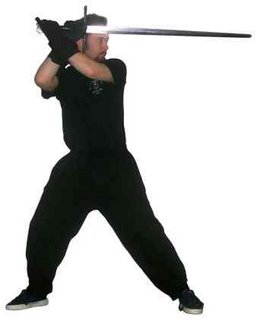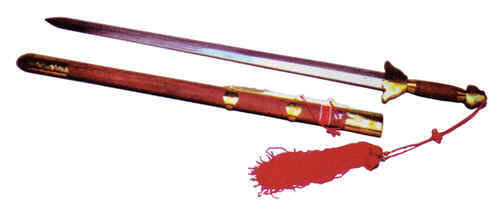Friday, June 23, 2006
Weapons
The core syllabus taught at SESH includes the following weapons: Each weapon is taught according to one basic system, with sufficient techniques and exercises that the student will achieve a firm understanding of the character of the weapon. The techniques are always derived from a particular historical treatise, but the drills and training method are usually Mr Windsor's own. Every weapon requires a different style of footwork, and often radically different body mechanics, to wield effectively. Footwork, basic guard positions, and basic body movements are drilled before weapon handling begins.
Each weapon is taught according to one basic system, with sufficient techniques and exercises that the student will achieve a firm understanding of the character of the weapon. The techniques are always derived from a particular historical treatise, but the drills and training method are usually Mr Windsor's own. Every weapon requires a different style of footwork, and often radically different body mechanics, to wield effectively. Footwork, basic guard positions, and basic body movements are drilled before weapon handling begins.The last of the duelling sidearms, the smallsword was developed towards the end of the seventeenth century, and remained popular for settling affairs of honour until replaced by the pistol.
Two styles of smallsword use are taught at the school: the 'common method', for which Domenico Angelo's School of Fencing (1787), is the core treatise; and Sir William Hope's radical and idiosyncratic New Method (1707).

Backsword

The backsword was a military and civilian sidearm popular throughout Europe in various forms from the early sixteenth century to the end of nineteenth. The training at the school recognises three arenas of backsword use: the military sabre, the SESH method of which is based on Harry Angelo's treatise (1798); the civilian sidearm, the SESH method of which is based on Zachary Wilde's treatise and others; and the sporting "cudgel play", which is not practiced at the school.
Students commonly begin training in this weapon with the singlestick, a wooden stick of the correct length, with a basket covering the hand, before moving on to steel.

Rapier
The archetypal duelling weapon, the rapier is the second weapon in the syllabus. The rapier developed from the spada da lato, and was used throughout Europe from the end of the sixteenth to the end of the seventeenth century (and in Italy for much longer). The weapon itself changed quite significantly over this period, and there are many different styles of use.
At present, the rapier syllabus is focussed on the study of Capo Ferro's Gran simulacro dell'arte e dell'uso della scherma (1610).

The hand and a half sword, commonly called a longsword or a bastard sword, was used by knights and men-at-arms from the end of the thirteenth century to the end of the fifteenth. All students begin with this weapon.
The core treatise for this weapon is Fiore dei Liberi's Fior Battaglia (1409). The training includes some of the unarmed and dagger techniques, as they are essential for understanding the fundamental concepts of Fiore's method. Some additional material comes from Vadi's De Arte Gladiatoria Dimicandi (c.a 1485).
The Lichtenauer-tradition German style is occasionally taught as a comparative study, usually by visiting instructors.
Friday, June 09, 2006
 The Chinese Sword
The Chinese SwordMedieval China saw great advancements in the science of metallurgy. They were far ahead of the technology available in Europe. These advancements allowed China to become a major military power. The power of the sword and arrived.
The basic techniques of forging and tempering developed in China. From these techniques, the renowned Japanese samurai swords were crafted. These skills arrived in Japan as early as the Sui and TAng Dynasty China AD 589.
Research has shown that the sword smiths of China were able to combine the following attributes over the past 20 centuries: Hard and durable edge, a resiliant body that absorbs shock without breaking. In a sword this is very difficult to achieve and found to be impossible to combine for centuries before.
Smiths were able to combine these two apparently incompatible attributes by combining hard and soft steels in various ways. hard steel tends to be brittle but strong. Soft steel tends to be resilient and springy but not strong and easily bendable.
There are 3 basic methods: There is Baogang or wrapped steel method. The hard high carbon steel forms the cutting edge and encloses a softer core of mild steel. The core metal is often folded on itself to increase density and strength. A baogang blade must be made with fairly thick jacket of hard steel or else it will lose it's sharpness after some use.
A more common form of blade forging is qiangang, or "inserted"steel. The high-carbon edge forms a core with is sandwiched between "cheeks" of mild steel. The cheeks are often made of alternating layers of iron and steel, which produce a pattern on the surface when the blade is polished. A skilled smith can manipulate the layers to produce patterns of great beauty, in addition to providing structural strength to the sword.
The last major type of forging is known in the West as "twistcore". This type is formed of parallel bars of twisted layers of hard and soft steel, all welded into a single unit under heat and hammer. When ground and polished, the surface resembles rows of feathery, star-shaped, or swirling elements.
Other technological advancements involved hardening the blade through the use of heat and quenching in liquid. This technique is universal today wherever blades are manufactured. China was one fo the few places in which techniques were devised to differentially heat treat the edge as opposed to the entire blade. This technique was then further perfected by the Japanese, who used the skill labor of enslaved Chinese and Korean Smiths.
Thursday, June 08, 2006
The Weapons and Fighting Gear of Ancient China

The most popular Shaolin Kung Fu 'tool' wass the staff. A long stick that had a variety of uses and purposes. It is a multi-purpose implement that can be used for many things other than self defense. A staff is used as a walking stick, to carry loads on your back, carry and transport two water buckets, as a lever, tent pole, writing implement (in the sand) and many more. This is also the weapon that almost all Chinese martial arts consider to be "The Father of all Weapons". It is also highly effective and recommended for all martial artists to learn.
There were of course many staff types as there are different woods, people and ways of using. But in general most staffed weapons can be but into 5 specific sizes(general lengths - all Shaolin weapon dimensions were measured in 'natural' measurements relating to the user);
Dragon Staff (app 1� person lengths or 8 to 9 foot)
Shaolin Staff (app 1 person length or 5� to 6� foot[also Rat Tail Staff, very flexible, Bai La Wood])
Carry Staff (app � person length)
Cudgel or Walking Stick (app half person length and very stout)
Flute, Ruler (app fore arm to fore arm and hand length)

Virtually any item that comes to hand can be used as an item of defence.
Clubbing or blunt weapons were popular among the Shaolin Monk Kung Fu practitioner for several reaons. Because of their spiritual beliefs they didn't believe in hurting or killing. Although a blunt weapon could hurt, it was difficult to kill someone with a staff or stick. What you would most likely do is subdue the attacker and hurt them. Many of them originated as farm tools and then became more refined and specialized with time.
Flexible weapons were the most difficult to master and the least understood. Few students ever mastered or took the time and discipline necessary to learn a flexible shaolin kung fu weapon. When we think about flexible weapons, we think of the 9 ring chain whip, the three sectional staff and many other. These weapons were the complete opposite to the sword and staff. They required a great deal of talent and training to master.
Some weapons of the China was designed to be used from a distance. Distance is preferable as a good defense and for secret attacks. Shaolin monks are normally not in the business of secretly attacking people, so these were rarely used and in very extreme circumstances. These weapons were common amonst vagabonds, assasins and ninjas. They were considered to be weapons of unfavorable reputation.
Shaolin Kung Fu and Chinese Martial Arts has 4 basic weapons: The staff, the broadsword, the spear, and the straight sword. These are the 4 basic weapons of Kung Fu and Chinese Martial arts and one that all serious martial artists should master.
The Staff - The Father of All Weapons
The Broad Sword - The Marshall of All Weapons
The Spear - The King of All Weapons
The Straight Sword - The Gentleman of all Weapons

The origin of all weapons are as follows: The knife, the stick, the spear, the rope, and the hammer. From here all the weapons of the martial arts have grew and flourished. From these basic tools, we can find every martial art weapon of the tree.
Knife
Stick
Spear
Rope
Hammer
| Non Standard Weapons | Pounding or Bludgeoning Weapons | Sharp Edged Weapons | Flexible Weapons | Throwing Weapons |
| Sash Bench Chopsticks Iron Comb Flute Iron Ring Iron Ruler Iron Smoking Pipe Iron Toad Mandarin Duck Spade Monk Cudgel Monk Spade Whip Chain Rake Ring Wheel Scholar's Brush Pen Sickle Tiger Fork Four Section Sickle Steel Fan Hoe Dragon Whisker Fork Ox Horn Fork Two Point Fork Two Teeth Fork Flail Rope | Crutch or Cane Dragon Head Stick Eight Corner Hammer Golden Melon Hammers Buddha Hand Cymbals Hammer Hook Lashing Staff Mace Mother and Son Hammer Shield Three Section Staff Flail Two Section Staff Water Parting Shield Wolf Teeth Club Wolf Teeth Hammer | Arhat Coin Axe , Dagger Axe, Long Stick Axe Brush Attacker Brush, Wolf Claw, Long Handed Claw, Talon Comb, Palace Heaven Crescent Rake Daggers, Twin Fist, Brass Fork Short Fork, Flying Fork, Horse Fork, Scholar Fork, Steel Fork, Wolf Teeth Spiked Halberd , Horse Halberd , Large Horse Halberd, Single Ended Halberd, Twin Ended Halberd Hand, Buddha Heaven Lotus Phoenix Tail Heaven Lotus Wind Tail Tan Hoe Hook, Fire Hook, Nine Teeth Knives , Butterfly Knives , Deer Antler Knives, Double Deer Antler Kris (Sword Breaker) L Shaped Halberd Lance, Long Lance Pincers, Long Handed Rake Rod , Nine Chi Tapered Rod, Eighteen-Chi Tapered Rod Scissor & Ruler Shovel, Golden Bell Shovel, Golden Coin Shovel, Heaven Tangled Shovel, Lotus Flower Shovel/Spade Sickle Spade , Gold Coin Spade, Convenient Spade, Crescent Moon Spade, Golden Bell Spade, Lotus Flower Spear , Double Headed Spear , Hooked Single Spear, Hook-Scythe Double Spear, Hook-Scythe Spear, Snake Spear, Throwing Spear, throwing Spear, Wolf Spear Sting, Moon Tooth Sting, Emei Piercers Stirring Heaven Killer Sword, Cicada Wing Sword, Eagle Head Sword, Heaven & Earth, Sun & Moon Sword, Horse Chopping Sword, Large Long Handed Broad Sword, Broad, Ghost Head Sword, Broad, Long Sword, Broad, Nine Hook Sword, Broad, Nine Ring Sword, Broad, Southern Sword, Broad, Swallow Tail Sword, Broad, Twin Sword, Broad, Two-Handed Sword, Butterfly Double Sword, Dashing Sword, Eyebrow Tip Sword, Hook Sickle Sword, Kick Sword, Long Handed Elephant Nose Sword, Long Handled Sword, Long-Handed Yue Fei Sword, Ox Ear Sharp Sword, Sleeve Sword, Slip or Thin Sword, Straight, Piercer Sword, Straight, Snake Sword, Straight, 3 Point Double-Blade Sword, Straight, Twin Sword, Straight, Two-handed Sword, Straight, Unicorn Horn Tree Knot | 7-12 Section Whip Bull Whip Rope Weighted Rope Kriss Sword Breaker Double Headed Comet Star Hammer Double Headed Flying Maul Iron Chain Linking Club Three Section Staff Soft Hammer Stick Soft Whip Four Section 'Tang' Rope Dart Comet Star Hammer Dragon Head Whip Club Dragon or Plum Flower Claw Flying Claw/Hook Lether Soft Whip Hook Swords | Bow & Arrow Crossbow Back Cross Bow Fly Whisk Flying Dart Flying Fork Flying Locust Stone Flying Knife Flying Weight Meteor Hammer Dart Knife Rope Javelin Rope Sling Shot Sling Shot Mother Sun Cross Darts Sleeve Arrow Blow Dart Flying Sting Brass Chopsticks Iron Madarin Duck Blum Flower Needles (Red) Poison Sand |
Subscribe to Comments [Atom]
